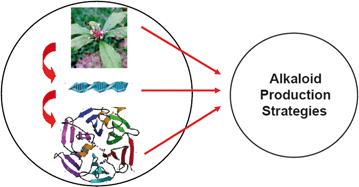Trends for diverse production strategies of plant medicinal alkaloids
Abstract
Covering: 1999 to 2009
Alkaloids represent a large and highly diverse

* Corresponding authors
a
Institute of Materia Medica, College of Pharmaceutical Sciences, Zhejiang University, 388 Yu Hang Tang Road, Hangzhou, P. R. China
E-mail:
joesto2000@yahoo.com
Fax: +86-571-88208449
Tel: +86-571-88208451
Covering: 1999 to 2009
Alkaloids represent a large and highly diverse

 Please wait while we load your content...
Something went wrong. Try again?
Please wait while we load your content...
Something went wrong. Try again?
L. Yang and J. Stöckigt, Nat. Prod. Rep., 2010, 27, 1469 DOI: 10.1039/C005378C
To request permission to reproduce material from this article, please go to the Copyright Clearance Center request page.
If you are an author contributing to an RSC publication, you do not need to request permission provided correct acknowledgement is given.
If you are the author of this article, you do not need to request permission to reproduce figures and diagrams provided correct acknowledgement is given. If you want to reproduce the whole article in a third-party publication (excluding your thesis/dissertation for which permission is not required) please go to the Copyright Clearance Center request page.
Read more about how to correctly acknowledge RSC content.
 Fetching data from CrossRef.
Fetching data from CrossRef.
This may take some time to load.
Loading related content
